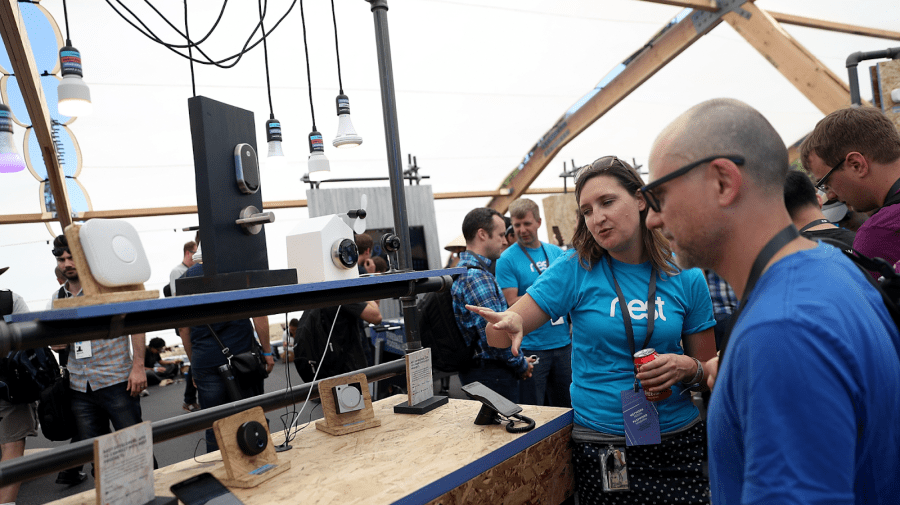
These days, not all WiFi routers provide an equally high-quality experience. While you may be familiar with your standard, run-of-the-mill WiFi router, you might not know too much about a newer kind of option that offers what’s known as mesh WiFi. Google mesh WiFi, and the related products, are some of the most popular — but there’s certainly more than one mesh option on the market.
Also called Whole Home WiFi, these systems blanket your home in coverage, eliminating those pesky far-away-from-the-router dead zones. So, how does a mesh WiFi system provide such full, comprehensive WiFi coverage? And how do they differ from more traditional routers and WiFi setups? Here, we’re breaking down everything you need to know about mesh WiFi so that you can determine if it’s the right fit for your home.
What Is Google Mesh WiFi?
Google mesh WiFi, like all mesh WiFi or Whole Home WiFi, is a system that’s designed to spread your wireless connectivity evenly throughout your entire home. Whereas traditional WiFi setups may provide better connectivity while you’re within a certain range of the router, a mesh WiFi system aims to blanket your home in WiFi coverage.
Rather than rely on a single router, Google mesh WiFi systems (like all mesh WiFi systems) consist of a main router that connects directly to your modem. To ensure full coverage, this main router connects with a series of satellite nodes, which are placed around your home. These devices share an SSID and password; instead of having multiple routers placed throughout your home each with their own traits, mesh WiFi essentially provides more access points and stronger connectivity across a single wireless network.

By creating a more comprehensive coverage area, Google mesh WiFi, and other mesh WiFi systems, makes certain that you’ll connect to the clearest, fastest bandwidth available — no matter how far from the main router you might roam. As a result, mesh WiFi systems can help you cut down on dropped video calls, streaming interruptions and other common (and commonly frustrating) connectivity issues.
Not to mention, these systems are designed with juggling multiple devices in mind, so there’s less spontaneous buffering if you and another member of your household are both trying to stream content at the same time.
Google WiFi vs. Google Nest
Currently, Google offers two different mesh WiFi systems: Google WiFi and Google Nest. Google WiFi, the first of the two systems, was introduced in 2016, while Google Nest came onto the scene in 2019. Yes, both systems can be used to set up a mesh WiFi network, but there are a few differences between the two options.
Google WiFi
Google WiFi comes with up to three identical “points,” any of which can be used as a router — so long as it’s connected to your modem. You can place the other two anywhere in your house, making these additional devices range extenders of sorts.
While there’s no need to directly connect your device with an Ethernet cable if you’re using WiFi, each point features two ports in case you ever want to do so. The points that come with Google WiFi are a bit less fancy than those that accompany Google Nest; for starters, they all look the same and come in one color. Another drawback? There aren’t any speakers or microphones, which means no virtual assistant or voice-activated commands.

Google Nest
Unlike its predecessor, Google Nest comes with a dedicated router that’s separate, and different looking, from the additional access points. While the router comes with Ethernet jacks, the other points don’t have any, which is something to consider if you like to connect directly.
However, each point does feature a built-in microphone and speaker, letting the devices double as smart speakers. This feature is extra handy if you want other voice-activated smart home benefits — turning lights and other devices on and off, playing music, changing your thermostat or even running a speed check on your network. Google Nest also offers a Family WiFi setting, which allows parents to restrict certain content and pause WiFi on specific devices to help manage their kids’ screen time.
Overall, Google Nest is a bit more expensive than Google WiFi, but it’s also capable of a whole lot more — and boasts faster network speeds. But, still, both options can be set up and controlled with the handy Google Home app, all while providing a reliable Google mesh WiFi network. That said, the choice kind of boils down to what features you’re most interested in. Another bit of good news? Google WiFi and Google Nest can also be used in combination with each other, making it easy to start out with the basics and then transition to a more robust setup later on.
What Does Google Mesh WiFi Require?
Google mesh WiFi products are designed to replace your current router, so you won’t be able to use them in combination with it. Both systems will, however, work with your existing ISP and modem. Google mesh WiFi devices can be connected to said modem with an Ethernet cable, which is included with most of these Google products. Luckily, there’s no need for any other cables; those satellite nodes just require wall outlets for power.
So, do you need anything else? Besides internet service, of course, Google recommends you to have a Google account and a smartphone, tablet or other device that runs on either Android 6.0 (or later), or iOS 13.0 (or later). Having these things in order means you’ll be able to download the Google Home app. The app will actually walk you through the entire setup process in just a few minutes, like a digital, step-by-step instruction manual.
Once your Google mesh WiFi network is set up, you can connect all of your wireless devices — like laptops, tablets, smart appliances and printers — to it. The only devices you may struggle to connect are incompatible WPA and WEP devices, such as older printers. Otherwise, it’s all pretty seamless.
So, Is It Worth It?
Whether or not it makes sense to trade in your current router for a mesh system, let alone a Google mesh WiFi setup, really depends on your needs. Are you happy with your current wireless coverage? If not, it may be time to look elsewhere.

For instance, if you live in a large house and find yourself sticking to specific rooms to avoid interruptions or dead zones, then a mesh network may be worth it. Of course, that’s not the only use case. If you have a lot of people living in your household, several folks who work or study from home, or gaming and streaming enthusiasts, then having a mesh network can ensure you all enjoy the internet without lag or other issues. Not to mention, a Google mesh WiFi setup is a natural next step if you’re investing in other smart home tech, like Google Nest.
If, on the other hand, you live in a relatively small house or apartment and don’t tend to have difficulties with connectivity, then it may not be worth shelling out the extra cash. Many modern centralized routers are built with streaming capabilities in mind, so they’re more up to the task of keeping individuals or smaller households connected without interruptions. In the end, find the solution that’s best for your unique needs.






